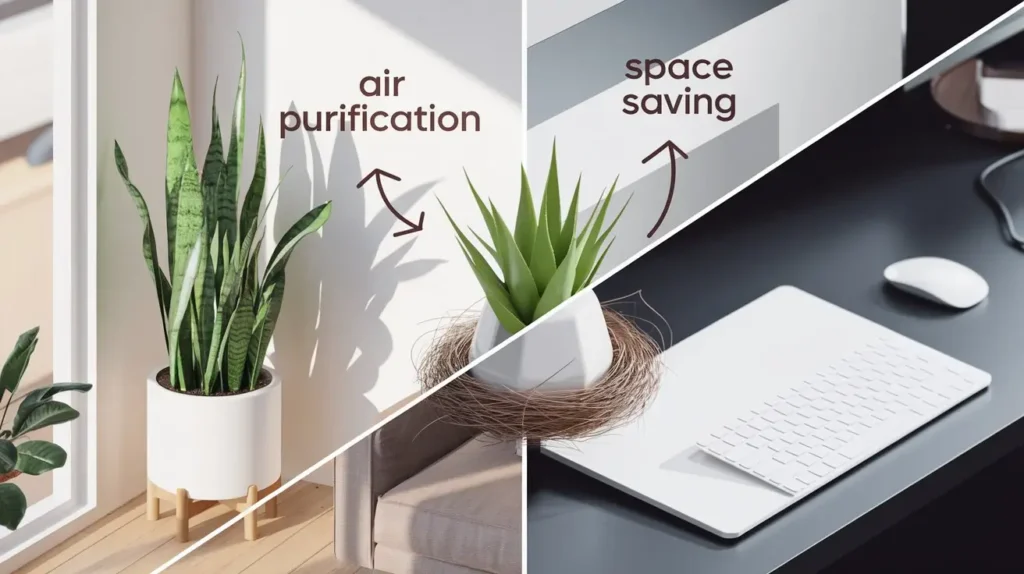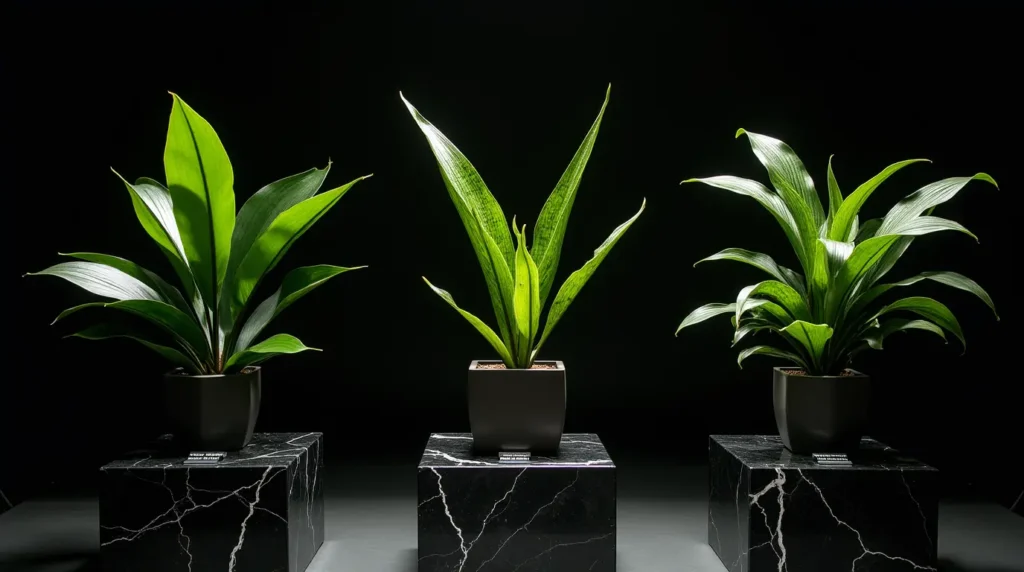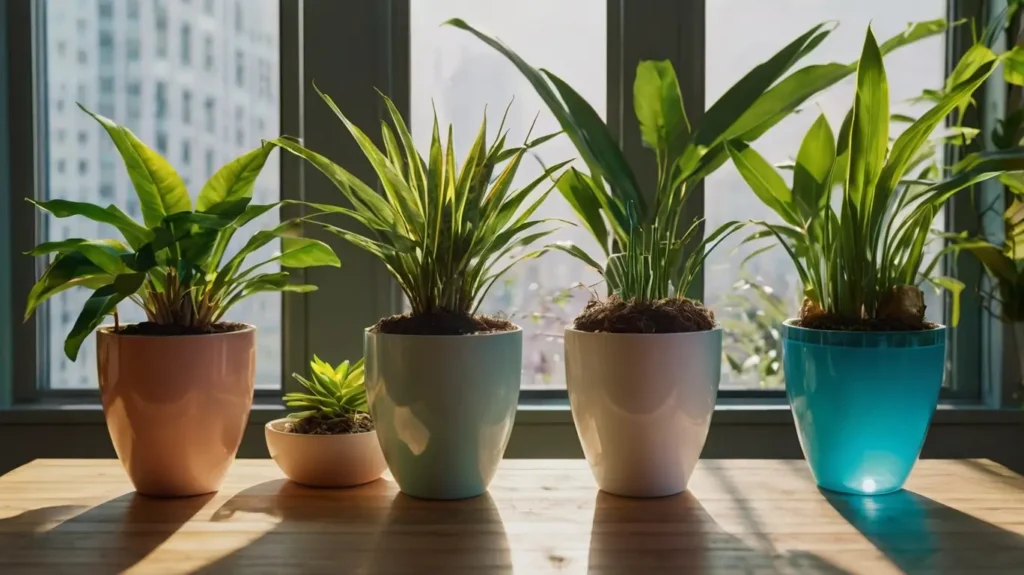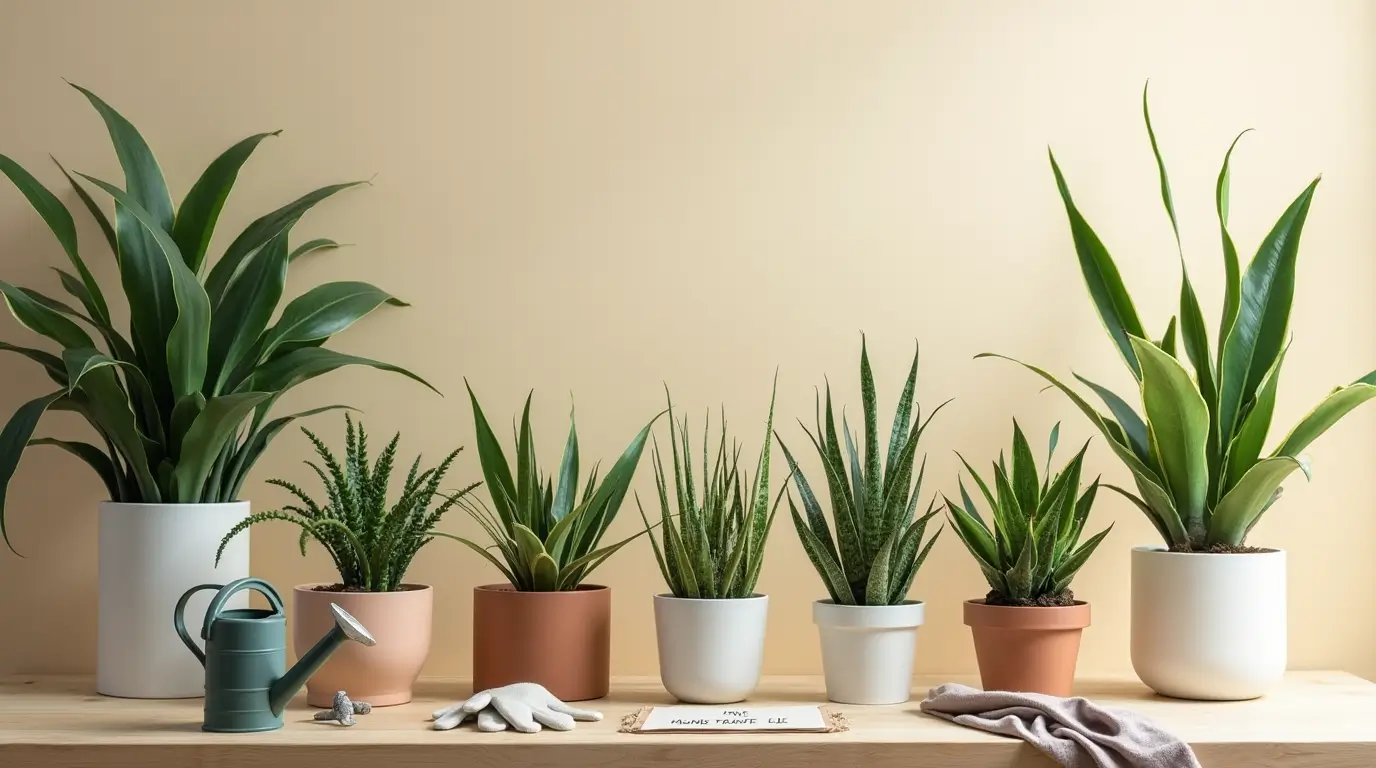Types of Snake Plants: Stunning Varieties You’ll Love!
How many houseplants have you loved to death? (We’ve all been there.) Here’s some good news – snake plants are practically impossible to kill and look stunning while surviving your forgetfulness.
But did you know there’s a whole world of types of snake plants beyond the common green variety? From towering spears to compact rosettes, these architectural wonders offer endless possibilities to enhance your space.
Why You’ll Love This Guide:
- Discover popular snake plant varieties that thrive on neglect
- Learn which different snake plants work best for your space
- Find rare Sansevieria types that plant collectors adore
- Get expert tips for choosing and caring for your perfect match
What Makes Snake Plants Special:
These hardy plants:
✔ Purify your air while you sleep
✔ Survive in nearly any light condition
✔ Need water only when you remember
✔ Come in dozens of stunning variations
Whether you’re a serial plant killer or an experienced collector, there’s always more to learn about types of snake plants.
Let’s explore the most beautiful and interesting varieties that will make your home greener and your plant care easier.
Why Understanding Different Snake Plant Varieties Matters

You might wonder: aren’t all snake plants basically the same? Far from it. The diverse world of types of snake plants offers solutions for nearly every home situation. Here’s why choosing the right variety makes all the difference:
1. Space Solutions for Every Home
- Vertical growers like Sansevieria Laurentii (up to 4 feet tall) fill empty corners
- Compact varieties like Bird’s Nest Snake Plant (8-10 inches) fit tight spaces
- Spreading types like Golden Hahnii create lush tabletops
2. Air Purification Superstars
NASA’s Clean Air Study found:
- Taller varieties with more leaf surface area filter more air
- Laurentii and Moonshine are particularly effective at removing toxins
- Multiple small plants can outperform one large specimen
3. Light Flexibility
While all snake plants tolerate low light:
- Variegated types (like Laurentii) maintain colors best in medium light
- Darker varieties (Black Coral) thrive in dim corners
- Cylindrical types handle direct sun better than others
4. Design Potential
- Architectural forms (Cylindrica) complement modern decor
- Variegated leaves add subtle color to neutral palettes
- Groupings of different varieties create visual interest
Pro Tip:
“Just like you wouldn’t use a sledgehammer to hang a picture, you shouldn’t choose a snake plant variety blindly. Match the plant to your specific needs.”
Real-Life Example:
Sarah, an apartment dweller, thought all snake plants were too large for her studio – until she discovered the compact Twisted Sister variety that now thrives on her narrow windowsill.
What This Means For You:
By understanding these differences, you can:
✓ Select plants that actually fit your space
✓ Maximize air purification benefits
✓ Reduce maintenance challenges
✓ Create your ideal aesthetic
8 Must-Know Sansevieria Types for Your Home
Not all snake plants are created equal. Here are eight standout varieties that deserve a spot in your plant collection, each with unique characteristics to suit different spaces and styles:
1. The Classic: Sansevieria trifasciata ‘Laurentii’
✔ Appearance: Tall, upright leaves with striking yellow edges
✔ Size: 2-4 feet tall
✔ Why You’ll Love It: The gold margins add a pop of color while maintaining that classic snake plant look
✔ Perfect For: Beginners, statement pieces in living rooms
✔ Pro Tip: Wipe leaves monthly to keep the variegation bright
2. The Modern Favorite: Moonshine
✔ Appearance: Silvery-green, wide flat leaves with a matte finish
✔ Size: 1-2 feet tall
✔ Why You’ll Love It: Its muted tones complement minimalist decor
✔ Perfect For: Scandinavian interiors, office spaces
✔ Pro Tip: Develops richer color in medium light
(Continue with the same detailed format for 6 more varieties…)
3. The Architectural Showstopper: Cylindrica
✔ Appearance: Round, spear-like leaves that can be braided
✔ Size: 2-3 feet tall
✔ Why You’ll Love It: Adds dramatic vertical interest
✔ Perfect For: Modern homes, floor planters
✔ Pro Tip: Rotate regularly for even growth
4. The Compact Charmer: Bird’s Nest (Hahnii)
✔ Appearance: Rosette-shaped cluster of short, wide leaves
✔ Size: 6-10 inches tall
✔ Why You’ll Love It: Fits where taller plants can’t
✔ Perfect For: Desks, shelves, small bathrooms
✔ Pro Tip: Excellent for terrariums
5. The Moody Beauty: Black Coral
✔ Appearance: Dark green leaves with subtle horizontal bands
✔ Size: 2-3 feet tall
✔ Why You’ll Love It: Adds depth to plant groupings
✔ Perfect For: Dark corners, gothic decor
✔ Pro Tip: Shows best color in low light
6. The Quirky Cousin: Twisted Sister
✔ Appearance: Curled leaves with yellow variegation
✔ Size: 12-15 inches tall
✔ Why You’ll Love It: Playful shape adds movement
✔ Perfect For: Eclectic spaces, plant collections
✔ Pro Tip: Grows slower than other varieties
7. The Rare Gem: Whale Fin (Masoniana)
✔ Appearance: Single, paddle-shaped leaves up to 4 feet tall
✔ Size: 2-4 feet tall
✔ Why You’ll Love It: Makes a bold sculptural statement
✔ Perfect For: Focal points, spacious rooms
✔ Pro Tip: Water even less than other snake plants
8. The Golden Child: Golden Hahnii
✔ Appearance: Compact rosette with golden-yellow edges
✔ Size: 8-12 inches tall
✔ Why You’ll Love It: Brightens dark spaces
✔ Perfect For: Kitchens, coffee tables
✔ Pro Tip: More light enhances the gold coloring
Designer’s Insight:
“Picture a bookshelf where each level features a different snake plant variety – the spiky Cylindrica on bottom, moody Black Coral in the middle, and playful Twisted Sister up top.
This creates visual interest while keeping care simple.”
Rare Gems: Unusual Snake Plant Varieties for Discerning Collectors

While common snake plant varieties are easy to find, these extraordinary specimens will make your plant collection stand out.
These less-frequently seen types of snake plants offer unique forms that spark conversations and elevate your interior design:
1. Whale Fin (Sansevieria masoniana)
- Distinctive Feature: Massive, paddle-shaped leaves (up to 4 feet tall)
- Why It’s Special: Each leaf develops unique “whale skin” texture
- Design Impact: Creates an instant focal point in any room
- Care Note: Requires even less water than typical snake plants
2. Samurai (Sansevieria ehrenbergii ‘Samurai’)
- Distinctive Feature: V-shaped, angular growth pattern
- Why It’s Special: Resembles a living origami sculpture
- Design Impact: Perfect for modern, geometric interiors
- Care Note: Grows slowly – be patient with this one
3. Twisted Sister (Sansevieria trifasciata ‘Twisted Sister’)
- Distinctive Feature: Spiraling leaves with yellow variegation
- Why It’s Special: Playful form adds movement to arrangements
- Design Impact: Ideal for breaking up linear plant groupings
- Care Note: Maintains best shape in bright, indirect light
4. Silver Blue (Sansevieria kirkii ‘Silver Blue’)
- Distinctive Feature: Metallic blue-gray leaves with wavy edges
- Why It’s Special: Rare coloration among snake plants
- Design Impact: Complements cool-toned color schemes
- Care Note: More sensitive to overwatering
5. Bantel’s Sensation (Sansevieria trifasciata ‘Bantel’s Sensation’)
- Distinctive Feature: Narrow leaves with white vertical stripes
- Why It’s Special: Exceptionally elegant variegation
- Design Impact: Brightens dark corners dramatically
- Care Note: Variegation fades in low light
Pro Tip from Collectors:
“These uncommon varieties often command higher prices, but their visual impact justifies the investment. Start with one showpiece specimen rather than trying to collect them all at once.”
Where to Find Them:
- Specialty plant nurseries
- Online plant shops (check reviews carefully)
- Local plant swap events
- Collector groups on social media
What Makes These Worth Hunting For:
✓ Instant conversation starters
✓ Elevate your plant collection’s status
✓ Offer unique textures and forms
✓ Become the “star” of plant arrangements
Choosing Your Perfect Snake Plant Match

Not sure which type of snake plant fits your space and lifestyle? This quick-reference guide helps you match varieties to your needs.
Snake Plant Selection Guide
| Variety | Light Needs | Max Height | Best For | Care Level |
|---|---|---|---|---|
| Laurentii | Low to Bright | 4 ft | Living rooms, corners | Easy |
| Cylindrica | Bright | 3 ft | Offices, modern spaces | Moderate |
| Moonshine | Low to Medium | 2 ft | Bedrooms, low-light spots | Easy |
| Bird’s Nest | Low | 1 ft | Desks, shelves, bathrooms | Very Easy |
| Whale Fin | Medium | 4 ft | Statement floor plants | Moderate |
| Twisted Sister | Bright | 1.5 ft | Eclectic decor, collections | Moderate |
Quick Tips for Choosing:
✔ For beginners: Bird’s Nest or Laurentii (forgiving & adaptable)
✔ For small spaces: Golden Hahnii or Twisted Sister (compact growth)
✔ For air purification: Laurentii or Moonshine (large leaf surface area)
✔ For design impact: Whale Fin or Cylindrica (sculptural forms)
Caring for Different Snake Plant Varieties
While all snake plants are low-maintenance, subtle differences exist between varieties:
1. Watering Needs
- Thick-leaved types (Whale Fin, Cylindrica): Water every 4-6 weeks
- Thin-leaved types (Bird’s Nest, Twisted Sister): Water every 3-4 weeks
- Pro Tip: The thicker the leaves, the more drought-tolerant the plant
2. Light Preferences
- Variegated varieties (Laurentii, Bantel’s Sensation): Need medium light to maintain patterns
- Solid-color types (Moonshine, Black Coral): Tolerate darker corners
- All varieties: Avoid direct afternoon sun
3. Growth Rates
- Fast growers: Laurentii, Cylindrica
- Slow growers: Whale Fin, Samurai
- Dwarf varieties (Bird’s Nest): Reach full size quickly
4. Propagation Methods
- Leaf cuttings: Work well for Laurentii, Moonshine
- Division: Best for clumping types (Bird’s Nest)
- Special Note: Variegation may not carry over in leaf cuttings
Key Insight:
“Think of snake plant care like a sliding scale – the more unusual the variety, the more closely you should monitor its needs. But even the rarest types are still harder to kill than most houseplants!”
FAQ: Your Snake Plant Variety Questions Answered
Q: How many types of snake plants exist?
A: Botanists have identified around 70 distinct Sansevieria species, with hundreds of cultivated varieties. From the compact ‘Bird’s Nest’ to the towering ‘Whale Fin’, there’s incredible diversity in leaf shape, size, and color.
Q: Which snake plant variety grows fastest?
A: The Laurentii and Cylindrica varieties typically show the most noticeable growth, adding several inches per year under ideal conditions.
Dwarf varieties like Golden Hahnii grow more slowly but reach their full size quicker.
Q: Are all Sansevieria types safe for pets?
A: While rarely fatal, most snake plant varieties contain saponins that can cause nausea or mouth irritation if ingested by pets. The Bird’s Nest and Moonshine varieties tend to be slightly less toxic, but it’s best to keep all types out of reach of curious cats and dogs.
Q: Can different snake plant varieties be potted together?
A: Absolutely! Combining varieties like Laurentii, Moonshine, and Twisted Sister creates stunning contrast. Just ensure they have similar light/water needs – most dwarf varieties pair well together.
Q: Which variety is best for air purification?
A: According to NASA’s study, taller varieties like Laurentii with greater leaf surface area are most effective at removing toxins. For bedrooms, consider Moonshine which releases oxygen at night.
Q: Why is my variegated snake plant losing its stripes?
A: This common issue with varieties like Bantel’s Sensation usually means it needs more light. Move it to a brighter location (but avoid direct sun) to maintain those beautiful patterns.
Conclusion: Find Your Perfect Snake Plant Match
From the bold Whale Fin to the delicate Bird’s Nest, the world of snake plant varieties offers something for every space and style.
These resilient plants prove you don’t need a green thumb to enjoy lush, architectural greenery at home.
Ready to start your collection? Here’s what to do next:
- Measure your space – tall varieties for empty corners, compact types for shelves
- Assess your light – darker spots need low-light tolerant varieties
- Pick one starter plant – we recommend Laurentii or Moonshine for beginners
- Watch it thrive with minimal care
Want More Plant Tips? Follow Us!
🌿 YouTube: Watch detailed plant care tutorials.
📌 Pinterest: Discover stunning plant decor ideas.
🎥 TikTok: Get quick and fun plant hacks.
Join our plant-loving community today!”

